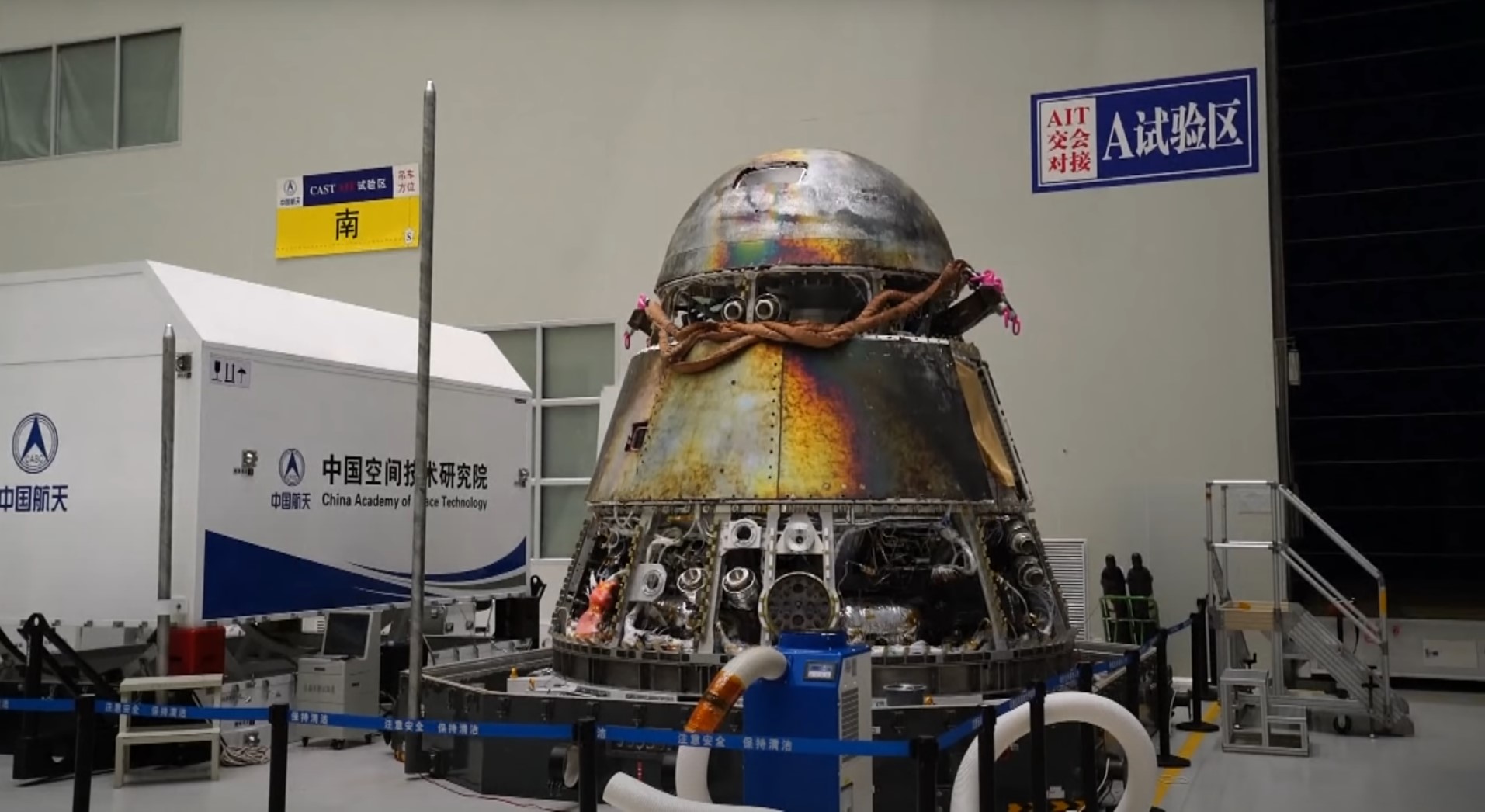China’s next-generation crew capsule was given an updated timeline this week. According to Yang Liwei, deputy chief designer of China’s Human Spaceflight Program, the new capsule will make its first flight in 2027 or 2028. Meeting this timeline will be a key milestone in China’s recently announced plan to land on the Moon by 2030.
The as-yet-unnamed crew capsule has been under development since 2016. The first flight of China’s medium-lift rocket, the Long March 7, carried a scale prototype of the vehicle as its test payload in June of that year.
By May 2020, a test vehicle had been developed and prepared for launch. It was carried to orbit on a Long March 5B, where it spent two days before returning to Earth. The test flight put the vehicle’s avionics through their paces, but it was mostly aimed at demonstrating the vehicle’s re-entry capabilities, including new heat shielding, new parachutes, and a cushioned airbag landing system. The heat shielding, according to designers, should allow for partial reuse of the vehicle.
Yang, who became China’s first astronaut to reach orbit in 2003, called the return module test “successful,” and indicated that work is ongoing to prepare the completed capsule for a maiden flight within five years.
“The new-generation spacecraft will be used for the crewed lunar mission, construction of the China Space Station and deep space exploration,” said Yang, speaking at a university on July 18, 2023.
The design of the new spacecraft includes two modules: the propulsion module and the return module.
This is a significant change from China’s current crewed spacecraft design, Shenzhou, which is based on the architecture of the Russian Soyuz capsules. An aerospace technology sharing program between Russia and China in the 1990s led to Shenzhou’s development, which is slightly larger than Soyuz but shares its three-module design, including a service module, a re-entry module, and an orbital module.

The new spacecraft will be bigger still, able to carry up to seven passengers. There may be different versions of the service module, depending on whether the mission takes place in low Earth orbit or deep space. Zhang Hailian, another deputy chief designer of China’s Human Spaceflight Program, says that the ability to carry 4-7 passengers opens up new opportunities for space tourism.
Recent updates to China’s lunar plans indicate that Chinese missions to the Moon will require two rockets. The first will carry the new spacecraft with astronauts aboard, and the second will carry a 26-tonne lunar descent vehicle. The two vehicles will dock in lunar orbit, unlike the Apollo missions, which carried out their docking maneuver in Earth orbit (although launched on one rocket, the Apollo descent module and command module were not connected properly until reaching Earth orbit). NASA’s planned Artemis Moon landings will also require two rockets, with the astronauts meeting their descent module at a planned space station called the Lunar Gateway.
China’s descent module is designed to carry two astronauts to the lunar surface. Engineers have also been working on a lunar rover and a mobile laboratory.


Ouch! “The two vehicles will dock in lunar orbit, unlike the Apollo missions, which carried out their docking maneuver in Earth orbit (although launched on one rocket, the Apollo descent module and command module were not connected properly until reaching Earth orbit).”
This is somewhat of a big mishap in an else interesting article, despite that it is morally – distance wise – almost factual. Famously the Apollo CSM crew capsule+service module was released, turned around and docked to the LEM lunar excursion module en route to Moon, It happened about one hour after the immense Saturn V restarted third stage had put them on a translunar injection orbit from a temporary parking LEO orbit, so nearly LEO – but if you ask the astronauts nothing like it since they were going to the Moon proximity no matter what. The parking orbit was for checking out the crafts, and I assume if the later docking didn’t work the lone CSM craft was going through a circumlunar return trajectory. So it was a calculated risk (with various alternative scenarios if release mechanisms between crafts and stages didn’t work).
“On Apollo 11, TLI came at 2 hours and 44 minutes after launch. The S-IVB burned for almost six minutes, giving the spacecraft a velocity close to the Earth’s escape velocity of 25,053 mph (40,319 km/h). This gave an energy-efficient transfer to lunar orbit, with the Moon helping to capture the spacecraft with a minimum of CSM fuel consumption.[11]
About 40 minutes after TLI, the Apollo command and service module (CSM) separated from the third stage, turned 180 degrees, and docked with the Lunar Module (LM) that rode below the CSM during launch. The CSM and LM separated from the spent third stage 50 minutes later, in a maneuver known as transposition, docking, and extraction.[11]” [“Saturn V”, Wikipedia]
By the way, it was the Saturn V capability to put 140 mt in LEO – including third stage useful mass – that makes the difference to the vastly inferior SLS remake of the previous Moon show production. It doesn’t matter that the new crew capsule is much less mass efficient. The SLS is made of LEO launcher parts that includes simple ballistic rocket technology (solid boosters) and a hydrolox sustainer (first stage, despite hydrolox being so inefficient then!). It wouldn’t be able to send an Apollo mission to Moon.
Neither will HSP or Starship, New Glenn et cetera of course. (Even if a future Starship can put 200 mt in LEO, it is out of propellant and need a refill.) The Apollo/Saturn combo was specialized – not too hard as Skylab demonstrated – and there is no one paying for a repeat of it. But it was nice show while it lasted!